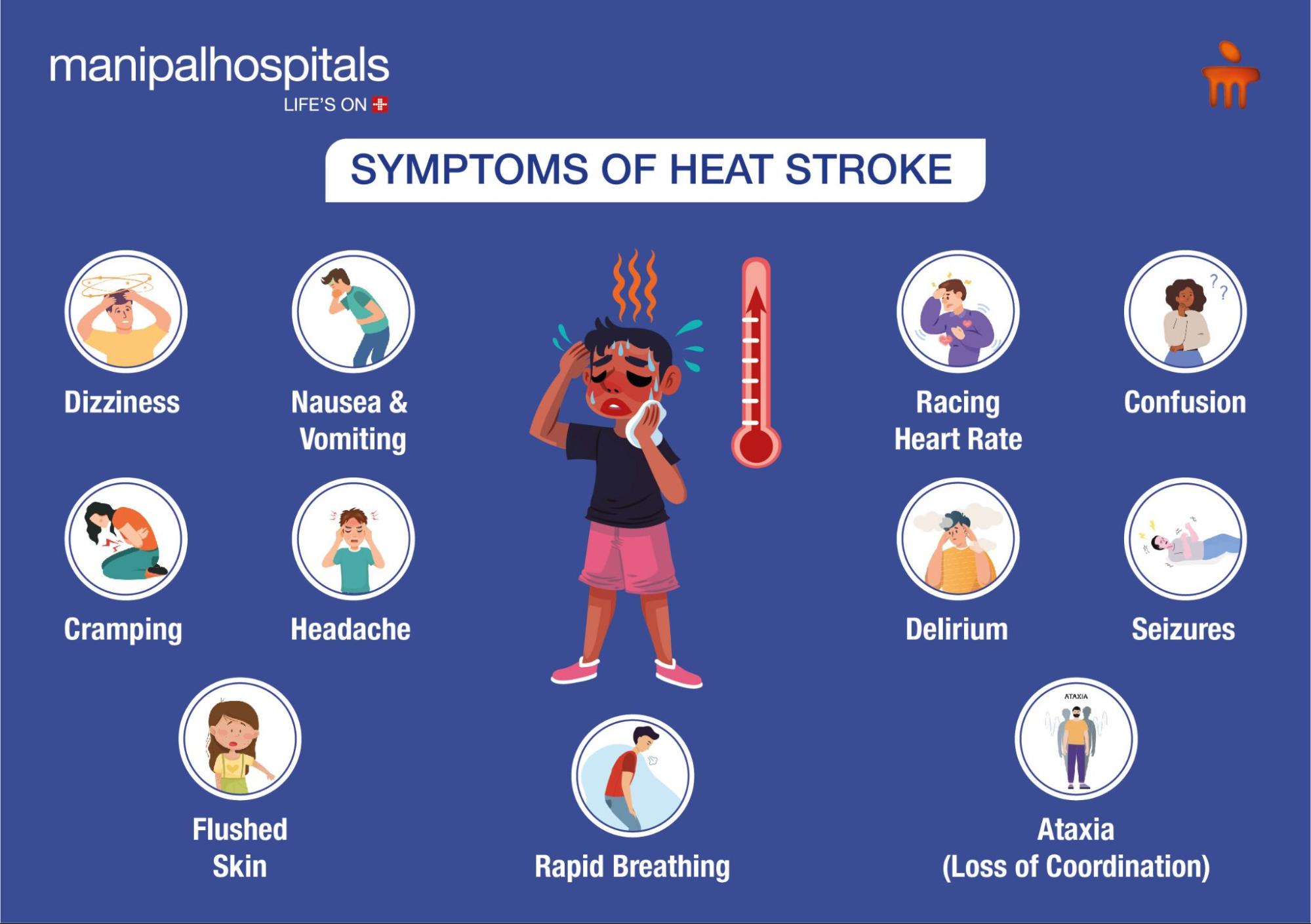Working, playing, or training in a scorching climate can be an exhausting and even dangerous experience. Unfortunately, this is the harsh reality for outdoor workers and athletes, who often have no choice but to endure it. Spending too much time in extreme heat can cause heat stroke, which may become life-threatening in severe cases
This blog explores what heat stroke is, its signs and symptoms, effective heat stroke prevention strategies, and how to treat heat stroke at home.
Synopsis
What is Heat Stroke?
Heatstroke is a serious heat-related condition marked by a significant rise in body temperature, usually but not always above 40°C or 104°F. It is the most severe stage of heat-related illnesses. Heatstroke commonly occurs during the summer months and can develop when the body overheats due to a combination of factors such as high temperatures, intense physical activity, clothing that limits sweat evaporation, poor adaptation to the heat, excess body fat, or low physical fitness.
There are two types of heat stroke: classic and exertional. Classic heat stroke usually affects older adults with existing medical conditions, while exertional heat stroke occurs in otherwise healthy individuals who perform strenuous exercise in hot or humid conditions. It is often seen in athletes and outdoor workers exposed to high temperatures.
Heat illness can progress rapidly in athletes and outdoor workers, with early signs of heat stroke often being hard to detect. However, early diagnosis and timely treatment can be life-saving, and exertional heat stroke prevention is possible.
Signs and Symptoms of Heat Stroke

Here are the signs and symptoms to watch for in cases of heat stroke. If you or someone nearby shows signs of heat stroke, contact emergency services right away.
Heat Stroke Prevention
Preventing heat illness means taking simple steps ahead of time. If you are playing sports or working outside, these tips can help you stay safe:
General Prevention Tips
-
Acclimatise gradually: Allow your body to adjust to the heat over several days, especially if you haven’t been active in hot environments recently.
-
Stay hydrated: Drink plenty of water regularly—don’t wait until you feel thirsty. Sports drinks can help replace electrolytes lost through sweat.
-
Avoid alcohol and sugary drinks: These can increase dehydration.
-
Wear appropriate clothing: Choose lightweight, loose-fitting, and light-coloured clothes. A wide-brimmed hat and sunscreen (reapplied as directed) add extra protection.
-
Schedule smart: Whenever possible, plan strenuous tasks for the cooler parts of the day—early morning or evening.
-
Take breaks in cool areas: Use air-conditioned spaces or shaded areas for recovery during and after work or training sessions.
-
Support one another: Encourage coworkers and teammates to rest, hydrate, and monitor each other for signs of heat illness.
Workplace Strategies
-
Modify workloads: Slow the pace of physically demanding tasks. Consider shorter shifts with frequent breaks in shaded or cooler spots.
-
Improve air flow: Use fans, air conditioning, or ventilation to boost evaporative cooling and reduce heat stress.
-
Train for safety: All workers and supervisors should receive training on recognising heat illness symptoms and how to respond with first aid.
Athlete-Specific Tips
-
Cooler is better: Frequent cooling breaks during practice can make a big difference. Use shade, cold tubs, misting fans, and ice water for recovery.
-
Adjust practice intensity: As temperatures rise, slow the pace, shorten sessions, and increase rest periods.
-
Fuel with high-water foods: Fruits and vegetables help boost hydration naturally.
-
Choose sports drinks wisely: These are often better than plain water because they provide sodium, sugars, and flavour to promote fluid retention and encourage drinking.
-
Ease into training: Don’t jump from a sedentary lifestyle into intense summer workouts. Begin with moderate activity, like 30 to 45 minutes of daily jogging, to kick-start heat adaptation.
-
Monitor high-risk athletes: In football, heavier players and linemen are particularly vulnerable. Look out for early signs of trouble like dizziness, poor coordination, or unusual fatigue.
-
Watch hydration markers: Urine colour should be pale like lemonade. A darker colour (like apple juice) may signal dehydration.
Heat Stroke Treatment at Home
Heat stroke is a medical emergency that can lead to permanent damage or even death if not treated quickly. While waiting for professional help, here are the key first aid steps you can take:
1. Move to a Cooler Area
-
Immediately take the person to a shaded, well-ventilated, or air-conditioned space.
-
Lay them down with their feet slightly elevated to improve blood flow.
2. Remove Excess Clothing
- Take off any unnecessary or tight clothing to help the body cool down faster.
3. Begin Active Cooling
-
Wet the skin with cool (not ice-cold) water using a sponge, spray bottle, or damp cloth.
-
Fan the person to speed up evaporation and cooling.
-
Use a garden hose, a cool shower, or place them in a tub with cool water if possible.
4. Target Key Cooling Zones
- Apply ice packs or cool, damp cloths to areas where blood vessels are close to the surface: the neck, armpits, groin, and back.
5. Offer Fluids (If Conscious)
-
If the person is alert and able to swallow, offer sips of cool water or a sports drink with electrolytes.
-
Avoid alcohol, caffeine, and sugary beverages.
6. Monitor and Support
-
Keep checking their temperature and aim to lower it to between 38.3°C and 38.9°C (101°F–102°F).
-
Do not give fever-reducing medications like aspirin or acetaminophen, as they may worsen the condition or mask symptoms.
7. In Case of Emergency
- If the person becomes unresponsive or shows no signs of circulation (breathing, movement, or coughing), begin CPR immediately.
Always call emergency services right away if you suspect heat stroke. These first aid steps can help stabilise the person, but medical treatment is essential.
Conclusion
Heat stroke is a serious condition that occurs when the body overheats and is unable to cool itself. It often results from prolonged exposure to high temperatures and is especially common among outdoor workers and athletes training in hot conditions. Understanding heat stroke, recognising its symptoms, and knowing basic first aid can play a key role in heat stroke prevention. If you are at risk, visit Manipal Hospitals, Broadway, for expert guidance and effective strategies on heat stroke prevention and care.
FAQ's
Cold water immersion is the quickest and most effective way to lower body temperature and reduce the risk of serious complications. If not available, use cool water and fanning to help with cooling.
The body loses heat most quickly through the head, neck, armpits, chest, and groin areas with high blood flow. Up to 45 per cent of body heat can be lost through the head and neck alone, especially in cold water.
Heat cramps are painful muscle spasms, often in the arms, legs, or abdomen, caused by heavy sweating during intense activity. They are more common in people who lose a lot of salt through sweat. Those with heart conditions or on low-sodium diets should consult a doctor if cramps occur.
In hot weather, drink more fluids even if you are not active. Don’t wait to feel thirsty. During intense activity, drink enough cool, non-alcoholic fluids to keep your urine light in colour and at a normal level.
Start slow and let your body adjust to the heat. If you feel lightheaded, weak, or short of breath, stop immediately. Move to a shaded or cool area and rest.






















 7 Min Read
7 Min Read













